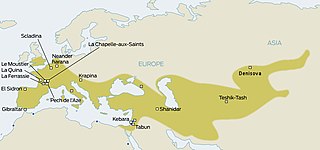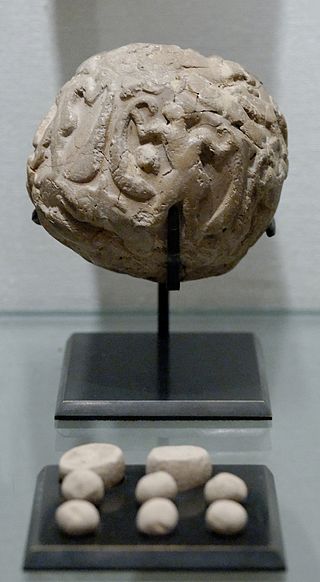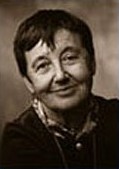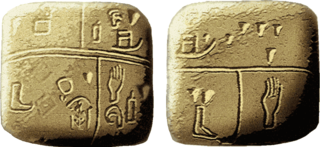Related Research Articles

Cognition is the "mental action or process of acquiring knowledge and understanding through thought, experience, and the senses". It encompasses all aspects of intellectual functions and processes such as: perception, attention, thought, imagination, intelligence, the formation of knowledge, memory and working memory, judgment and evaluation, reasoning and computation, problem-solving and decision-making, comprehension and production of language. Cognitive processes use existing knowledge and discover new knowledge.
Dyscalculia is a disability resulting in difficulty learning or comprehending arithmetic, such as difficulty in understanding numbers, learning how to manipulate numbers, performing mathematical calculations, and learning facts in mathematics. It is sometimes colloquially referred to as "math dyslexia", though this analogy is misleading as they are distinct syndromes.
Cognitive archaeology is a theoretical perspective in archaeology that focuses on the ancient mind. It is divided into two main groups: evolutionary cognitive archaeology (ECA), which seeks to understand human cognitive evolution from the material record, and ideational cognitive archaeology (ICA), which focuses on the symbolic structures discernable in or inferable from past material culture.

Neanderthals became extinct around 40,000 years ago. Hypotheses on the causes of the extinction include violence, transmission of diseases from modern humans which Neanderthals had no immunity to, competitive replacement, extinction by interbreeding with early modern human populations, natural catastrophes, climate change and inbreeding depression. It is likely that multiple factors caused the demise of an already low population.

Mangareva is the central and largest island of the Gambier Islands in French Polynesia. It is surrounded by smaller islands: Taravai in the southwest, Aukena and Akamaru in the southeast, and islands in the north. Mangareva has a permanent population of 1,239 (2012) and the largest village on the island, Rikitea, is the chief town of the Gambier Islands.

The Proto-Elamite script is an Early Bronze Age writing system briefly in use before the introduction of Elamite cuneiform.

A bulla is an inscribed clay or soft metal or bitumen or wax token used in commercial and legal documentation as a form of authentication and for tamper-proofing whatever is attached to it.
A sign-value notation represents numbers using a sequence of numerals which each represent a distinct quantity, regardless of their position in the sequence. Sign-value notations are typically additive, subtractive, or multiplicative depending on their conventions for grouping signs together to collectively represent numbers.
Numerical cognition is a subdiscipline of cognitive science that studies the cognitive, developmental and neural bases of numbers and mathematics. As with many cognitive science endeavors, this is a highly interdisciplinary topic, and includes researchers in cognitive psychology, developmental psychology, neuroscience and cognitive linguistics. This discipline, although it may interact with questions in the philosophy of mathematics, is primarily concerned with empirical questions.

Denise Schmandt-Besserat is a French-American archaeologist and retired professor of art and archaeology of the ancient Near East. She spent much of her professional career as a professor at the University of Texas. She is best known for her work on the history and invention of writing. While her research is highly cited, it has been controversial among scholars. The controversies, as detailed below, concern the interpretation of early tokens, particularly the complex ones; however, the idea that writing emerged out of the counting, cataloging, management, and transactions of agricultural produce has been largely accepted.
Number systems have progressed from the use of fingers and tally marks, perhaps more than 40,000 years ago, to the use of sets of glyphs able to represent any conceivable number efficiently. The earliest known unambiguous notations for numbers emerged in Mesopotamia about 5000 or 6000 years ago.
Physicalization of computer hardware, is a way to place multiple physical machines in a rack unit. It can be a way to reduce hardware costs, since in some cases, server processors cost more per core than energy efficient laptop processors, which may make up for added cost of board level integration. While Moore's law makes increasing integration less expensive, some jobs require much I/O bandwidth, which may be less expensive to provide using many less-integrated processors.
Choghā Mīsh (Persian language; چغامیش čoġā mīš) dating back to about 6800 BC, is the site of a Chalcolithic settlement located in the Khuzistan Province Iran on the eastern Susiana Plain. It was occupied at the beginning of 6800 BC and continuously from the Neolithic up to the Proto-Literate period, thus spanning the time periods from Archaic through Proto-Elamite period. After the decline of the site about 4400 BC, the nearby Susa, on the western Susiana Plain, became culturally dominant in this area. Chogha Mish is located just to the east of Dez River, and about 25 kilometers to the east from the ancient Susa. The similar, though much smaller site of Chogha Bonut lies six kilometers to the west.
Neuroarchaeology is a sub-discipline of archaeology that uses neuroscientific data to infer things about brain form and function in human cognitive evolution. The term was first suggested and thus coined by Colin Renfrew and Lambros Malafouris.
Thomas G. Wynn is an American archaeologist known for his work in cognitive archaeology. He is a pioneer of evolutionary cognitive archaeology; his article "The intelligence of later Acheulean hominids" is considered a classic in the field. He taught at the University of Colorado, Colorado Springs from 1977 to 2022, where he now holds the title Distinguished Professor Emeritus.
Frederick L. Coolidge is an American psychologist known for his work in cognitive archaeology. He has been a Professor of Psychology at the University of Colorado, Colorado Springs since 1979. With Karenleigh A. Overmann, he currently co-directs the Center for Cognitive Archaeology at the University of Colorado, Colorado Springs. He also teaches for the Centre for Cognitive and Brain Sciences at the Indian Institute of Technology Gandhinagar, India.

The proto-cuneiform script was a system of proto-writing that emerged in Mesopotamia, eventually developing into the early cuneiform script used in the region's Early Dynastic I period. It arose from the token-based system that had already been in use across the region in preceding millennia. While it is known definitively that later cuneiform was used to write the Sumerian language, it is still uncertain what the underlying language of proto-cuneiform texts were.
Lambros Malafouris is a Greek-British cognitive archaeologist who has pioneered the application of concepts from the philosophy of mind to the material record. He is Professor of Cognitive and Anthropological Archaeology at the University of Oxford. He is known for Material Engagement Theory, the idea that material objects in the archaeological record are part of the ancient human mind.
April Nowell is a Paleolithic archaeologist, Professor of Anthropology and Distinguished Lansdowne Fellow at the University of Victoria, Canada. Her research team works on international projects in areas including Jordan, Australia, France, and South Africa.
References
- ↑ "UCCS Center for Cognitive Archaeology Faculty". University of Colorado, Colorado Springs. 2021. Retrieved June 3, 2021.
- 1 2 3 Overmann, Karenleigh A. (2019). The Material Origin of Numbers: Insights from the Archaeology of the Ancient Near East. Piscataway, NJ: Gorgias Press. ISBN 9781463207434.
- 1 2 3 Overmann, Karenleigh A (2020). "The Curious Idea that Māori Once Counted by Elevens, and the Insights It Still Holds for Cross-Cultural Numerical Research". Journal of the Polynesian Society. 129 (1): 59–84. doi: 10.15286/jps.129.1.59-84 . Retrieved 24 July 2020.
- ↑ Barras, Colin (2021). "How Did Neanderthals and Other Ancient Humans Learn to Count?". Nature. 594 (7861): 22–25. Bibcode:2021Natur.594...22B. doi: 10.1038/d41586-021-01429-6 . ISSN 0028-0836. PMID 34079134. S2CID 235322556 . Retrieved June 6, 2021.
- ↑ "On the Origin of Numbers". 2021. Retrieved June 6, 2021.
- ↑ Zahidi, Karim (2021). "Radicalizing Numerical Cognition". Synthese. 198 (1): 529–545. doi:10.1007/s11229-020-02956-x. S2CID 229433621.
- ↑ Dos Santos, César (2023). "Review of Karenleigh A. Overmann's The Materiality of Numbers". Qeios: 1–10. doi: 10.32388/MBBSHS . Retrieved 31 August 2023.
- ↑ Schmandt-Besserat, Denise (1992). Before Writing: From Counting to Cuneiform, Vol. II. Austin, TX: University of Texas Press. ISBN 9780292707832.
- ↑ Overmann, Karenleigh A (2016), Catalogue of Ancient Near Eastern Tokens, Unpublished, retrieved November 2, 2021
- ↑ Wilding, Denise; Rowan, Clare; Maurer, Bill; Schmandt-Besserat, Denise (2017). "Tokens, writing and (ac)counting: A conversation with Denise Schmandt-Besserat and Bill Maurer". Exchanges: The Interdisciplinary Research Journal. 5 (1): 1–14. doi: 10.31273/eirj.v5i1.196 . Retrieved January 6, 2022.
- ↑ Overmann, Karenleigh A (2020). "Counting by "Elevens" and Why Nine and Two make Twenty: The Material Roots of Polynesian Numbers". Journal of Mathematics and Culture. 15 (3): 1–32. Retrieved June 3, 2021.
- ↑ Overmann, Karenleigh A (2021). "A New Look at Old Numbers, and What It Reveals about Numeration". Journal of Near Eastern Studies. 80 (2): 291–321. doi:10.1086/715767. S2CID 239028709 . Retrieved October 23, 2021.
- ↑ Overmann, Karenleigh A (2016). "Beyond Writing: The Development of Literacy in the Ancient Near East". Cambridge Archaeological Journal. 26 (2): 285–303. doi:10.1017/S0959774316000019. S2CID 163840618.
- ↑ Overmann, Karenleigh A (2021). "A Cognitive Archaeology of Writing: Concepts, Models, Goals". In Boyes, Philip; Steele, Philippa; Astoreca, Natalia Elvira (eds.). The Social and Cultural Contexts of Historic Writing Practices. Oxford: Oxbow. pp. 55–72. ISBN 9781789254785.
- ↑ Overmann, Karenleigh A (2021). "Writing System Transmission and Change: A Neurofunctional Perspective". In Gabriel, Gösta; Overmann, Karenleigh A; Payne, Annick (eds.). Signs – Sounds – Semantics. Nature and Transformation of Writing Systems in the Ancient Near East. Wiener Offene Orientalistik 13. Wein: Ugarit-Verlag. pp. 93–116.
- ↑ Overmann, Karenleigh A (2022). "Early Writing: A Cognitive Archaeological Perspective on Literacy and Numeracy". Visible Language. 56 (1): 8–44. doi:10.34314/vl.v56i1.4934.
- ↑ Overmann, Karenleigh A (2021). "The Material Difference in Human Cognition". Adaptive Behavior. 29 (2): 123–136. doi: 10.1177/1059712320930738 . hdl: 11250/2766177 . S2CID 225657095.
- ↑ Overmann, Karenleigh A; Wynn, Thomas (2019). "Materiality and human cognition". Journal of Archaeological Method and Theory. 26 (2): 457–478. doi:10.1007/s10816-018-9378-y. S2CID 149605602.
- ↑ Overmann, Karenleigh A; Wynn, Thomas (2019). "On Tools Making Minds: An Archaeological Perspective on Human Cognitive Evolution". Journal of Cognition and Culture. 19 (1–2): 39–58. doi: 10.1163/15685373-12340047 . hdl: 1956/23288 . S2CID 181503453.
- ↑ Overmann, Karenleigh A (2024). "Writing as an extended cognitive system". Phenomenology and the Cognitive Sciences: 1–21. doi:10.1007/s11097-023-09955-6.
- ↑ Wynn, Thomas; Overmann, Karenleigh A; Coolidge, Frederick L (2016). "The false dichotomy: A refutation of the Neandertal indistinguishability claim". Journal of Anthropological Sciences. 94 (94): 201–221. doi:10.4436/jass.94022. PMID 26708102.
- ↑ Coolidge, Frederick L.; Wynn, Thomas; Overmann, Karenleigh A. (2024). "The Expert Neandertal Mind and Brain, Revisited". In Wynn, Thomas; Overmann, Karenleigh A.; Coolidge, Frederick L. (eds.). The Oxford Handbook of Cognitive Archaeology. Oxford University Press. ISBN 9780192895950.
- ↑ Overmann, Karenleigh A (2009). "Darcy and Emma: Jane Austen's ironic meditation on gender". Persuasions: The Jane Austen Journal. 31: 222–235. Retrieved June 5, 2020.
- ↑ Overmann, Karenleigh A (2009). "Cartesian Dualism, Real and Literary Madness in the Regency, and the Mind and Madness in Austen's Novels". Persuasions: The Jane Austen Journal. 35: 109–128. Retrieved June 5, 2020.